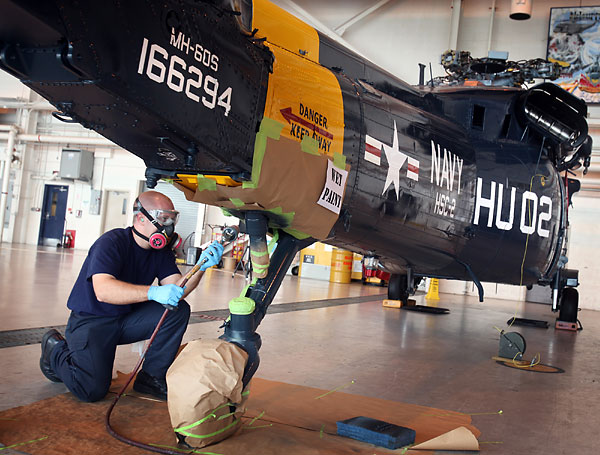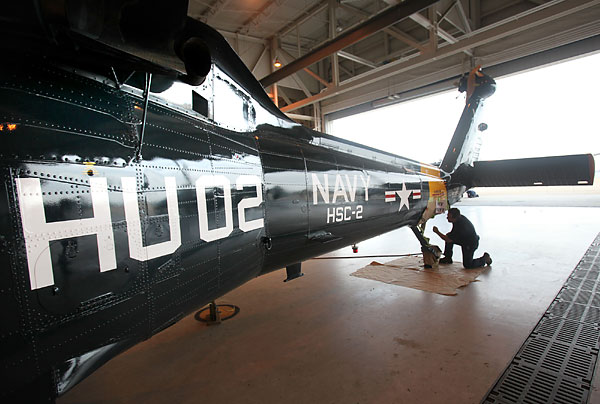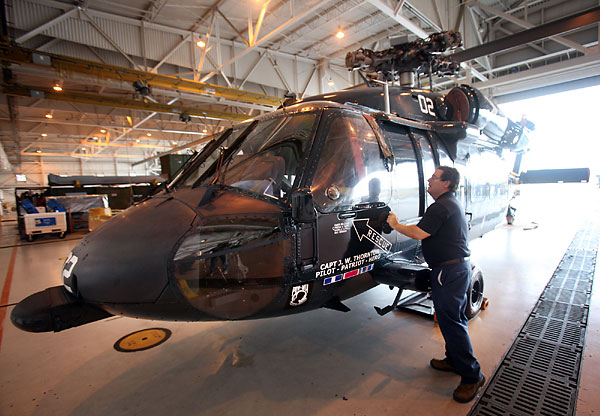


Well, these are the first photos of a "retro scheme" for the upcoming U.S. Navy Centennial 1911-2011 that I have stumbled upon so far. Anyone know more
Helicopter gets a new look - to honor history, aviation
1 of 7 photos:
The Virginian-Pilot
© October 14, 2010
NORFOLK
Mark Goggins rarely has occasion to buy paint that isn't gray.
He heads a team of civilian contractors who work on helicopters for the Navy.
Their job is to search for corrosion, then get rid of it and paint over their tracks.
In keeping with military regulation, every MH-60S in their squadron looks the same: mute gray with black lettering.
Except for one.
To mark the 2011 centennial of naval aviation, a handful of Hampton Roads air squadrons are breaking their typical paint schemes.
They're each repainting one aircraft - a helicopter or a fighter jet, depending on what they fly - to honor a particular period in their 100-year history.
One squadron has chosen to pay homage to the Vietnam era, another to the Cold War.
For the unit that Goggins' team works with, Helicopter Sea Combat Support Squadron 2 at Norfolk Naval Station, it's the Korean War.
This week, the team is putting its finishing touches on a once-gray chopper that's now a shiny blue.
"This is very different for us," said Goggins, who is employed by the government contractor DynCorp.
"This is like art. There's a lot of detail, a lot of creativity. We don't get to do this every day."
The helicopter's new look is the product of collaboration.
The squadron's commanding officer, Cmdr. Shelby Mounts, was the first to suggest a theme related to the Korean War, to which the squadron traces its roots.
He also suggested working in elements to honor one of the squadron's most decorated members, Capt. John W. Thornton, who flew in Korea.
Thornton, a Philadelphia native, is best known for volunteering in 1951 for a dangerous mission to rescue a key intelligence unit trapped in a mountainous region behind enemy lines.
The attempt ended with Thornton's capture. He spent 2-1/2 years as a prisoner of war and was later awarded the Navy Cross.
After he died in 2004, Helicopter Sea Combat Support Squadron 2 helped scatter his ashes off the coast of Norfolk.
"Capt. Thornton is a very important piece of our history," Mounts said.
With their theme decided, others in the squadron contributed specific ideas for incorporating Thornton's legacy into the helicopter's design.
Besides his name, the aircraft bears images of his medals and the "prisoner of war/missing in action" seal.
Others helped track down photos of helicopters from the Korean War era, which also inspired the final design.
The body work began about a month ago. Goggins' 10-person team started by cleaning and sanding the helicopter and removing corrosion.
Then they taped it to be spray painted. The details were added with stencils and a little bit of freehand work.
"It's more complicated than it might look," Goggins explained. "Because the squadron is still going to fly this helicopter, there's a lot of rules to follow.
We have to be precise in the amount of paint we use because of the weight."
The exact amount used? Eight gallons, or 60 pounds.
Mounts said some local squadrons chose not to repaint aircraft for the centennial because such alterations mean those planes can't be flown in combat missions.
For Mounts, that wasn't an issue because he heads a training squadron.
"We'll still be able to use this helicopter all the time, so it made sense for us," he said. "It's going to be a real point of pride to see it in the sky."






